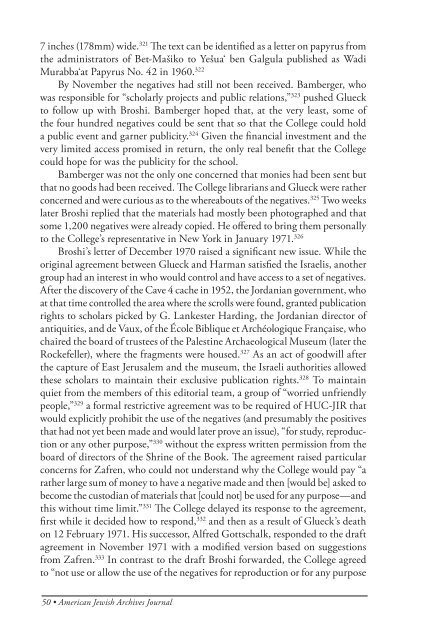The American Jewish Archives Journal, Volume LXI 2009, Number 1
The American Jewish Archives Journal, Volume LXI 2009, Number 1
The American Jewish Archives Journal, Volume LXI 2009, Number 1
You also want an ePaper? Increase the reach of your titles
YUMPU automatically turns print PDFs into web optimized ePapers that Google loves.
7 inches (178mm) wide. 321 <strong>The</strong> text can be identified as a letter on papyrus from<br />
the administrators of Bet-Mašiko to Yešua‘ ben Galgula published as Wadi<br />
Murabba‘at Papyrus No. 42 in 1960. 322<br />
By November the negatives had still not been received. Bamberger, who<br />
was responsible for “scholarly projects and public relations,” 323 pushed Glueck<br />
to follow up with Broshi. Bamberger hoped that, at the very least, some of<br />
the four hundred negatives could be sent that so that the College could hold<br />
a public event and garner publicity. 324 Given the financial investment and the<br />
very limited access promised in return, the only real benefit that the College<br />
could hope for was the publicity for the school.<br />
Bamberger was not the only one concerned that monies had been sent but<br />
that no goods had been received. <strong>The</strong> College librarians and Glueck were rather<br />
concerned and were curious as to the whereabouts of the negatives. 325 Two weeks<br />
later Broshi replied that the materials had mostly been photographed and that<br />
some 1,200 negatives were already copied. He offered to bring them personally<br />
to the College’s representative in New York in January 1971. 326<br />
Broshi’s letter of December 1970 raised a significant new issue. While the<br />
original agreement between Glueck and Harman satisfied the Israelis, another<br />
group had an interest in who would control and have access to a set of negatives.<br />
After the discovery of the Cave 4 cache in 1952, the Jordanian government, who<br />
at that time controlled the area where the scrolls were found, granted publication<br />
rights to scholars picked by G. Lankester Harding, the Jordanian director of<br />
antiquities, and de Vaux, of the École Biblique et Archéologique Française, who<br />
chaired the board of trustees of the Palestine Archaeological Museum (later the<br />
Rockefeller), where the fragments were housed. 327 As an act of goodwill after<br />
the capture of East Jerusalem and the museum, the Israeli authorities allowed<br />
these scholars to maintain their exclusive publication rights. 328 To maintain<br />
quiet from the members of this editorial team, a group of “worried unfriendly<br />
people,” 329 a formal restrictive agreement was to be required of HUC-JIR that<br />
would explicitly prohibit the use of the negatives (and presumably the positives<br />
that had not yet been made and would later prove an issue), “for study, reproduction<br />
or any other purpose,” 330 without the express written permission from the<br />
board of directors of the Shrine of the Book. <strong>The</strong> agreement raised particular<br />
concerns for Zafren, who could not understand why the College would pay “a<br />
rather large sum of money to have a negative made and then [would be] asked to<br />
become the custodian of materials that [could not] be used for any purpose—and<br />
this without time limit.” 331 <strong>The</strong> College delayed its response to the agreement,<br />
first while it decided how to respond, 332 and then as a result of Glueck’s death<br />
on 12 February 1971. His successor, Alfred Gottschalk, responded to the draft<br />
agreement in November 1971 with a modified version based on suggestions<br />
from Zafren. 333 In contrast to the draft Broshi forwarded, the College agreed<br />
to “not use or allow the use of the negatives for reproduction or for any purpose<br />
50 • <strong>American</strong> <strong>Jewish</strong> <strong>Archives</strong> <strong>Journal</strong>

















